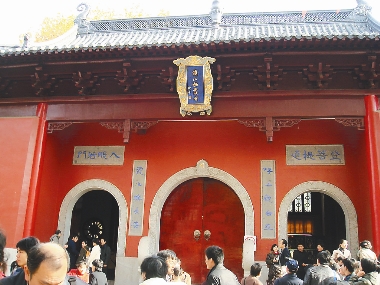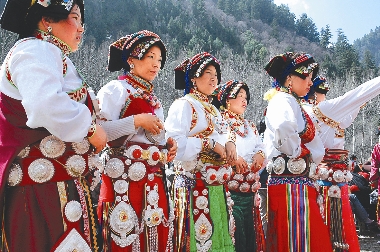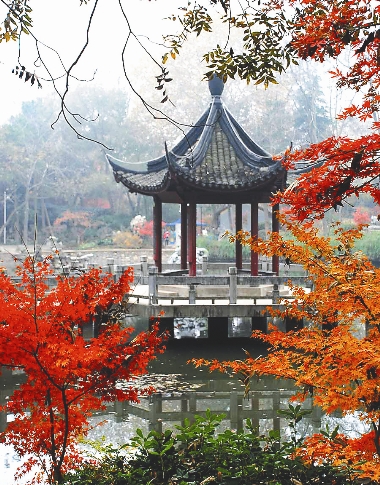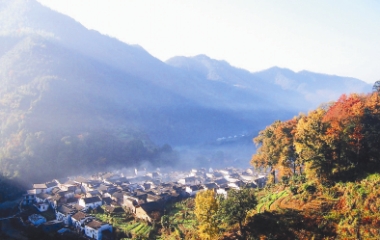 Miyaluo scenic spot Miyaluo in Lixian County, Sichuan Province, has the largest area of autumn leaves in China, covering almost 3,688 square kilometers. The area is about 180 times that of the well-known Fragrant Hills in Beijing. About 260 kilometers from Chengdu, capital of Sichuan Province, Miyaluo is inhabited by Tibetan and Qiang ethnic minority groups. In the Tibetan language Miyaluo means “a place with breathtaking scenery.” The place is hidden in Zagunao Valley, called “Auspicious Valley” in the Tibetan language, along a tributary of the Minjiang River. Maples, birch trees, pines, and larches add seasonal richness in color to the forests of Zagunao Valley. With the arrival of autumn, the mountains are covered in a blaze red and gold. The skyline of snowy mountains and colorful forests appear as if in a dream world. There is also Gu’ergou hot springs with water temperatures of 40 to 60 degrees Celsius. A skiing slope will open for the first time in November. The Tibetan and Qiang ethnic cultures are a highlight of Miyaluo. It’s great to visit the stone castles built in ancient times and join in the traditional guozhuang dance, one of three Tibetan dances where people dance hand in hand. Unaccompanied by music, men and women sing questions and answers. The dance resembles a religious ritual and there is no need to understand the language to feel the passion. Sheepskin vests of the Qiang people and coral belts of Tibetans are attractive souvenirs. The best time to visit is late October and early November. Transport: Fly to Chengdu. Take a bus at Chengdu West Gate Bus Station to Miyaluo. Delicacies: Sichuan hotpot is a must. Rice steamed in bamboo tube is also recommended as is a rice wine fermented by the local people.  Qixia Mountain There is a saying in Nanjing: “Spring’s Niushou and autumn’s Qixia.” Locals go to Niushou Mountain in spring and enjoy autumn views at Qixia Mountain. The most enchanted scenery in Qixia Mountain lies in the west, which is also called the maple range. Abounding in maple trees, the slope is covered in bright red in late autumn, attracting tourists from home and abroad. Qixia Mountain, called Sheshan Mountain in ancient times, is 22 kilometers from downtown Nanjing, capital of Jiangsu Province. The main peak is 286 meters above sea level. The eastern peak is named Dragon Mountain as it resembles a legendary dragon and the western peak is called Tiger Mountain. Natural spectacles, like “Die Lang Yan” (the wavy rock), and “Yi Xian Tian” (the thin-strip-of-sky cave), are recommended. Qixia Mountain is a good place to explore Buddhist culture and is rich in relics. Built in 489, Qixia Monastery is one of China’s Four Biggest Monasteries and the largest in Nanjing. The Monastery was rebuilt in 1908 by Emperor Guangxu in the Qing Dynasty (1644-1911). The main buildings include a mountain gate, several temples and pavilions. There is the Sheli Pagoda to the east of Qixia Monastery, built of white stone and 18 meters high. It has five floors and eight sides. The surface of the pagoda is decorated in relief, telling the story of the Sakyamuni Buddha. The Thousand Buddha Grottoes is next to the Sheli Pagoda. There are 294 Buddha shrines and 515 Buddha statues in different poses. The biggest statue is 11 meters high. Mirror Lake, west of the main buildings, is about 3,000 square meters in area. Transport: Fly to Nanjing. Take a bus from the Hanfu Street bus stop or Nanjing Railway Station. It is about 40 minutes’ ride from downtown Nanjing to Qixia Mountain and bus fare is 2.5 yuan. The bus runs between 6 a.m. and 7 p.m. Delicacies: Wild berries picked by the local people in the mountain can be bought at the Qixia Monastery gate. (Chen Ting)   | 
